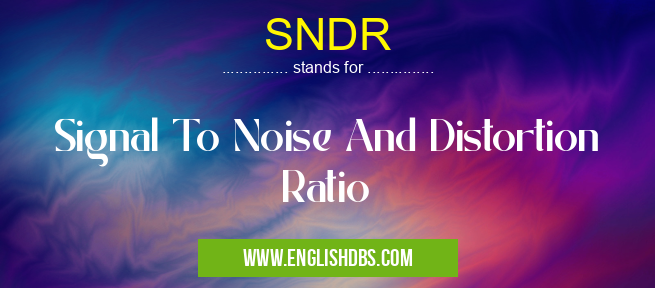What does SNDR mean in UNCLASSIFIED
SNDR is an abbreviation for Signal To Noise And Distortion Ratio. SNDR is a measure of the ratio between the desired signal that is being transmitted and any unwanted noise introduced during the transmission. It is expressed in decibels (dB). SNDR directly impacts the quality of a signal and the clarity of audio or video signals that are being sent over a medium.

SNDR meaning in Unclassified in Miscellaneous
SNDR mostly used in an acronym Unclassified in Category Miscellaneous that means Signal To Noise And Distortion Ratio
Shorthand: SNDR,
Full Form: Signal To Noise And Distortion Ratio
For more information of "Signal To Noise And Distortion Ratio", see the section below.
Essential Questions and Answers on Signal To Noise And Distortion Ratio in "MISCELLANEOUS»UNFILED"
What does SNDR stand for?
SNDR stands for Signal To Noise And Distortion Ratio.
Is SNDR expressed in decibels?
Yes, SNDR is expressed in decibels (dB).
How does SNDR affect transmission quality?
SNDR affects transmission quality by providing a ratio between the desired signal that is being transmitted and any unwanted noise introduced during the transmission. A higher SNDR ratio indicates better signal-to-noise performance, which leads to higher quality audio or video signals.
How does one improve an SNDR ratio?
Improving an SNDR ratio involves minimizing external sources of noise, eliminating internal noise sources such as ground loops, and optimizing signal routing strategies. Additionally, using high-quality components such as connectors, switches, amplifiers and cables can also help increase a system's signal-to-noise performance.
What applications require good signal-to-noise performance?
Applications requiring good signal-to-noise performance include audio recording/mixing applications, video/audio streaming services, network communications systems, VoIP telephony and wireless communication systems.
Final Words:
In summary, SNDR stands for Signal To Noise And Distortion Ratio. It provides measurements on how much desired signal has been transmitted compared to any unwanted noise introduced during transmission and it's expressed in dB. An improved SNDD ratio allows for clearer audio or video signals to be sent through technology systems or networks with less interference from external noises or equipment malfunctions.
